Intermediate Art by Goya
Francisco de Goya

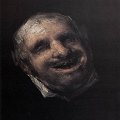 Francisco de Goya is an innovative Spanish Romanticism painter, one of the great Spanish masters. As an
artist, Goya was by temperament far removed from the classicals. In a
few works he approached Classical style, but in the greater part of
his work the Romantic triumphed. Straightforward candor and honesty
are present in all Goya's works. The subversive and subjective element
in his art, as well as his bold handling of paint, provided a model
for the work of later generations of artists. For the bold technique
of his paintings, the haunting satire of his etchings, and his belief
that the artist's vision is more important than tradition, Goya is
often called "the grandfather of modern art". Francisco de Goya became
one of the most influential figures in Spanish art of all time. He was
also extremely important in the development of modern aesthetic
sensibility, a forerunner of Romanticism, both in the content of his
paintings, with their in-depth exploration of reality and references
to the dream world, and in his very original technique.
Francisco de Goya is an innovative Spanish Romanticism painter, one of the great Spanish masters. As an
artist, Goya was by temperament far removed from the classicals. In a
few works he approached Classical style, but in the greater part of
his work the Romantic triumphed. Straightforward candor and honesty
are present in all Goya's works. The subversive and subjective element
in his art, as well as his bold handling of paint, provided a model
for the work of later generations of artists. For the bold technique
of his paintings, the haunting satire of his etchings, and his belief
that the artist's vision is more important than tradition, Goya is
often called "the grandfather of modern art". Francisco de Goya became
one of the most influential figures in Spanish art of all time. He was
also extremely important in the development of modern aesthetic
sensibility, a forerunner of Romanticism, both in the content of his
paintings, with their in-depth exploration of reality and references
to the dream world, and in his very original technique.
- Portrait Of Martin Zapater (1797)
- St. Gregory (1797)
- Gaspar Melchor De Jovellanos (1798)
- Josefa Bayeu (Or Leocadia Weiss) (1798)
- Portrait Of Andres Del Peral (1798)
- The Bewitched Man (1798)
- The Miracle Of St. Anthony (Detail) (1798)
- La Tirana (1799)
- Charles IV And His Family (1800)
- Portrait Of The Countess Of Chinchon (1800)
- The Nude Maja (La Maja Desnuda) (1800)
- Manuel Godoy, Duke Of Alcudia, 'Prince Of The Peace' (1801)
- The Clothed Maja (La Maja Vestida) (1803)
- Dona Isabel De Porcel (1805)
- Portrait Of Antonia Zarate (1805)
- Portrait Of A Lady With A Fan (1807)
- The Colossus (1808)
- Allegory Of The City Of Madrid (1810)
- Portrait Of Victor Guye (1810)
- Les Vieilles Or Time And The Old Women (1812)
- Portrait Of The Duke Of Wellington (1812)
- Still-Life, A Butcher's Counter (1812)
Portrait Of Martin Zapater (1797)
 Get
Get  a high-quality picture of
Portrait Of Martin Zapater for your computer or notebook. ‣
In his early schooling Goya made his lifelong friendship with Martin Zapater, with whom he would exchange correspondence for much of his life. Goya painted two portraits of Zapater, a wealthy corn-merchant, this portrait in Bilbao and seven years earlier another, now in a private collection.
a high-quality picture of
Portrait Of Martin Zapater for your computer or notebook. ‣
In his early schooling Goya made his lifelong friendship with Martin Zapater, with whom he would exchange correspondence for much of his life. Goya painted two portraits of Zapater, a wealthy corn-merchant, this portrait in Bilbao and seven years earlier another, now in a private collection.
St. Gregory (1797)
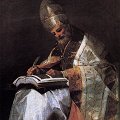 Get
Get  a high-quality picture of
St. Gregory for your computer or notebook. ‣
This belongs to a series of representations of the four Doctors of the Church, of which the St Augustine and St Ambrose are also extant. They are not documented but are reasonably assumed to have been painted after Goya's visit to Andalusia in 1796-97 both on stylistic grounds and because of their resemblance to Murillo's seated figures of St Isidore and St Leander in Seville Cathedral. In style and colour they also reflect Goya's earlier studies of Tiepolo.
a high-quality picture of
St. Gregory for your computer or notebook. ‣
This belongs to a series of representations of the four Doctors of the Church, of which the St Augustine and St Ambrose are also extant. They are not documented but are reasonably assumed to have been painted after Goya's visit to Andalusia in 1796-97 both on stylistic grounds and because of their resemblance to Murillo's seated figures of St Isidore and St Leander in Seville Cathedral. In style and colour they also reflect Goya's earlier studies of Tiepolo.
Goya's St Gregory, seated on a platform like Murillo's saints, is a monumental figure in an undefined space, without decor or attributes other than the large book and papal tiara to identify him as the pope said to have left the greatest number of writings.
Gaspar Melchor De Jovellanos (1798)
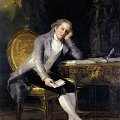 Get
Get  a high-quality picture of
Gaspar Melchor De Jovellanos for your computer or notebook. ‣
Goya painted this grand portrait of his friend and patron Jovellanos (1744-1811), the learned writer and liberal statesman, at the time of his appointment as Minister of Grace and Justice. The liberal patriot and nobleman fought - with increasing success - for reforms and against ignorance, superstition and the Inquisition. The portrait was painted while the court was at Aranjuez.
a high-quality picture of
Gaspar Melchor De Jovellanos for your computer or notebook. ‣
Goya painted this grand portrait of his friend and patron Jovellanos (1744-1811), the learned writer and liberal statesman, at the time of his appointment as Minister of Grace and Justice. The liberal patriot and nobleman fought - with increasing success - for reforms and against ignorance, superstition and the Inquisition. The portrait was painted while the court was at Aranjuez.
Not long afterwards Goya painted a portrait of Francisco de Saavedra, Minister of Finance, after he succeeded Godoy as Secretary of State (March 1798), in similar pose. Heroes of a brief liberal interlude, both ministers were soon to be relieved of their posts, victims of Godoy: Jovellanos to become a political prisoner in Mallorca for seven years. Jovellanos, who was 54 years old when he came to power and was painted by Goya, is known to have taken much trouble with his hair, here seen carefully dressed, as he refused to wear a wig. Goya has placed his sitter in a rich setting, with muted lighting, seated in melancholy pose, beside an ornate table covered with papers and with an inkwell. A statue of Minerva in bronze is a tribute to the sitter's great learning and distinguished position at the time of the painting. Jovellanos bequeathed Goya's portrait to his friend and protector, Arias de Saavedra.
Jovellanos as well as Goya used the language of satire to attack social and political abuse. The second of Goya's Caprichos in which a blind-folded young woman is led to the altar by an ugly old man, takes its caption from a verse by his patron: 'They say yes and offer their hand to the first comer.' The Minister's concern for prison reform also found a response in the artist in his many illustrations of the torture of prisoners.
Josefa Bayeu (Or Leocadia Weiss) (1798)
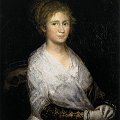 Get
Get  a high-quality picture of
Josefa Bayeu (Or Leocadia Weiss) for your computer or notebook. ‣
Depending on how they date this painting, art historians see in it a portrait either of Goya's wife Josefa or his subsequent partner Leocadia Weiss, who moved in with the artist in 1813, just one year after Josefa's death, and lived with him until his death.
a high-quality picture of
Josefa Bayeu (Or Leocadia Weiss) for your computer or notebook. ‣
Depending on how they date this painting, art historians see in it a portrait either of Goya's wife Josefa or his subsequent partner Leocadia Weiss, who moved in with the artist in 1813, just one year after Josefa's death, and lived with him until his death.
Portrait Of Andres Del Peral (1798)
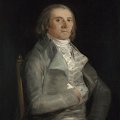 Get
Get  a high-quality picture of
Portrait Of Andres Del Peral for your computer or notebook. ‣
According to a modern label on the back of the picture, the sitter was a doctor of law, and financial representative of the Spanish government in Paris at the end of the eighteenth century. He is known to have been a collector and to have owned a number of paintings by Goya.
a high-quality picture of
Portrait Of Andres Del Peral for your computer or notebook. ‣
According to a modern label on the back of the picture, the sitter was a doctor of law, and financial representative of the Spanish government in Paris at the end of the eighteenth century. He is known to have been a collector and to have owned a number of paintings by Goya.
Goya's friend Carderera commented the painting that Goya 'had such care and love for the grand effect of a picture that he usually put the last touches on by night with artificial light, at times taking little account of whether the drawing was more or less accurate'.
The Bewitched Man (1798)
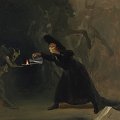 Get
Get  a high-quality picture of
The Bewitched Man for your computer or notebook. ‣
The inscription: LAM/DESCO (Lampara descomunal, 'extraordinary lamp') identifies the subject as a scene from El hechizado por fuerza ('The man bewitched by force'), a play by Antonio de Zamora. The protagonist, Don Claudio, is led to believe that he is bewitched and that his life depends on keeping a lamp alight. The play was first performed in 1698 and reprinted several times, including 1795, shortly before Goya's painting. Goya has represented the scene as a theatrical performance, on a stage with the dancing donkeys as a backcloth (in the play they are described as paintings on a wall). The goat that appears to hold a lamp is no more than a stage property but the fear that it inspires in Don Claudio is portrayed with dramatic realism.
a high-quality picture of
The Bewitched Man for your computer or notebook. ‣
The inscription: LAM/DESCO (Lampara descomunal, 'extraordinary lamp') identifies the subject as a scene from El hechizado por fuerza ('The man bewitched by force'), a play by Antonio de Zamora. The protagonist, Don Claudio, is led to believe that he is bewitched and that his life depends on keeping a lamp alight. The play was first performed in 1698 and reprinted several times, including 1795, shortly before Goya's painting. Goya has represented the scene as a theatrical performance, on a stage with the dancing donkeys as a backcloth (in the play they are described as paintings on a wall). The goat that appears to hold a lamp is no more than a stage property but the fear that it inspires in Don Claudio is portrayed with dramatic realism.
This was one of six pictures of witches and devils painted by Goya for the Alameda of the Duke and Duchess of Osuna and paid for in 1798. The subjects are similar to scenes of witchcraft in Los Caprichos on which Goya was working at this time.
The Miracle Of St. Anthony (Detail) (1798)
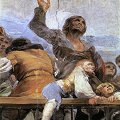 Get
Get  a high-quality picture of
The Miracle Of St. Anthony (Detail) for your computer or notebook. ‣
Behind the painted railing surrounding the cupola, Saint Anthony, in the presence of a Lisbon crowd, brings back to life a murdered man in order to establish his father's innocence of the crime.
a high-quality picture of
The Miracle Of St. Anthony (Detail) for your computer or notebook. ‣
Behind the painted railing surrounding the cupola, Saint Anthony, in the presence of a Lisbon crowd, brings back to life a murdered man in order to establish his father's innocence of the crime.
The church of San Antonio, a small neo-classical building on the outskirts of Madrid, was a royal chapel completed in 1798. The only document referring to Goya's decorations is an account for materials, 'for the work in the chapel of San Antonio de la Florida, which he carried out at His Majesty's bidding in this year, 1798'. The account, dated 20 December, covers the period between June and October and includes the cost of a carriage to take Goya to and from the church every day from 1 August until the completion of the work.
The decoration of the cupola, apse, lunettes and pendentives, executed in fresco with added touches of tempera, is unprecedented in Goya's oeuvre for the boldness and individuality of its style. The placing of the principal scene of the miracle on the walls of the cupola usually occupied by a representation of heaven is unconventional, like the decoration of the walls below with female angels and painted curtains. The effect of the whole is almost that of a secular decoration, strong in colour and free in handling.
Many years after his burial in Bordeaux, Goya's remains were taken back to Spain and since 1929 they have been entombed in this church.
La Tirana (1799)
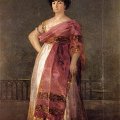 Get
Get  a high-quality picture of
La Tirana for your computer or notebook. ‣
The painting represents Maria del Rosario Fernandez, the famous actress. The title of the painting was originated from the fact that her husband, also an actor, frequently played the role of tyrants.
a high-quality picture of
La Tirana for your computer or notebook. ‣
The painting represents Maria del Rosario Fernandez, the famous actress. The title of the painting was originated from the fact that her husband, also an actor, frequently played the role of tyrants.
Charles IV And His Family (1800)
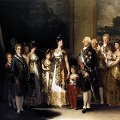 Get
Get  a high-quality picture of
Charles IV And His Family for your computer or notebook. ‣
Goya clearly had in mind for this royal group the composition of Velazquez's Meninas, which he had copied in an engraving many years before. Like Velazquez, he has placed himself at an easel in the background, to one side of the canvas. But his is a more formal royal portrait than Velazquez's: the figures are grouped almost crowded together in front of the wall and there is no attempt to create an illusion of space. The eyes of Goya are directed towards the spectator as if he were looking at the whole scene in a mirror. The somewhat awkward arrangement of the figures suggests, however, that he composed the group in his studio from sketches made from life. Goya is known to have made four journeys to Aranjuez in 1800 to paint ten portraits of the royal family. Since there are 12 figures in the group it is likely that the woman seen in profile and the woman whose head is turned away - the only two whose identity is uncertain were not present at the time.
a high-quality picture of
Charles IV And His Family for your computer or notebook. ‣
Goya clearly had in mind for this royal group the composition of Velazquez's Meninas, which he had copied in an engraving many years before. Like Velazquez, he has placed himself at an easel in the background, to one side of the canvas. But his is a more formal royal portrait than Velazquez's: the figures are grouped almost crowded together in front of the wall and there is no attempt to create an illusion of space. The eyes of Goya are directed towards the spectator as if he were looking at the whole scene in a mirror. The somewhat awkward arrangement of the figures suggests, however, that he composed the group in his studio from sketches made from life. Goya is known to have made four journeys to Aranjuez in 1800 to paint ten portraits of the royal family. Since there are 12 figures in the group it is likely that the woman seen in profile and the woman whose head is turned away - the only two whose identity is uncertain were not present at the time.
Goya's magnificent royal assembly is dominated not by Charles IV but by the central figure of the Queen, Maria Luisa, whose ugly features are accentuated by her ornate costume and rich jewels. For some unknown reason this was the last occasion that Goya is known to have painted any member of this royal family, except for the future Ferdinand VII, who stands in the foreground on the left. The unusual figure composition on the wall behind the group has been identified as Lot and his Daughters, but no such painting has been identified.
Portrait Of The Countess Of Chinchon (1800)
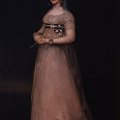 Get
Get  a high-quality picture of
Portrait Of The Countess Of Chinchon for your computer or notebook. ‣
The stunning dress, of a still Tiepolesque lightness, stands out against a timeless, unidentified background; but what really strikes us in this portrait is the totally unidealized face, and the closed, melancholy, uncomprehending expression which verges on idiocy. This is Maria Teresa de Vallabriga y Borbon, Countess of Chinchon, the daughter of Don Luis de Borbon and Maria Teresa de Vallabriga, and wife of Manuel Godoy, the favourite of Queen Maria Luisa.
a high-quality picture of
Portrait Of The Countess Of Chinchon for your computer or notebook. ‣
The stunning dress, of a still Tiepolesque lightness, stands out against a timeless, unidentified background; but what really strikes us in this portrait is the totally unidealized face, and the closed, melancholy, uncomprehending expression which verges on idiocy. This is Maria Teresa de Vallabriga y Borbon, Countess of Chinchon, the daughter of Don Luis de Borbon and Maria Teresa de Vallabriga, and wife of Manuel Godoy, the favourite of Queen Maria Luisa.
The Nude Maja (La Maja Desnuda) (1800)
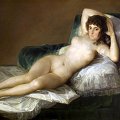 Get
Get  a high-quality picture of
The Nude Maja (La Maja Desnuda) for your computer or notebook. ‣
Goya's Majas (fashionable young women) are two of his most famous and most discussed masterpieces. Their date, for whom they were painted and the identity of the model are problems that are still not satisfactorily solved. The first mention of The Nude Maja is in the diary of the medallist Pedro Gonzalez de Sepulveda describing a visit in November 1800 to the house of the Minister, Manuel Godoy, Goya's patron and the target of his satire: 'In an apartment or inner cabinet are pictures of various Venuses... (among them) a naked one by Goya, without design or delicacy of colouring' and Velazquez's 'famous Venus'. There is no mention of The Clothed Maja and presumably it was not there, probably not yet painted.
a high-quality picture of
The Nude Maja (La Maja Desnuda) for your computer or notebook. ‣
Goya's Majas (fashionable young women) are two of his most famous and most discussed masterpieces. Their date, for whom they were painted and the identity of the model are problems that are still not satisfactorily solved. The first mention of The Nude Maja is in the diary of the medallist Pedro Gonzalez de Sepulveda describing a visit in November 1800 to the house of the Minister, Manuel Godoy, Goya's patron and the target of his satire: 'In an apartment or inner cabinet are pictures of various Venuses... (among them) a naked one by Goya, without design or delicacy of colouring' and Velazquez's 'famous Venus'. There is no mention of The Clothed Maja and presumably it was not there, probably not yet painted.
Godoy's position at court and his known taste for paintings of female nudes (there were many others in his collection) makes it likely that both Majas were painted for him. An alternative suggestion is that they were in the Duchess of Alba's collection and acquired by Godoy after her death, together with Velazquez's The Toilet of Venus and other pictures. Goya's relations with the Duchess of Alba have made her the most popular candidate as a model for the Majas, at least as a source of inspiration, supported by the many drawings of herself and members of her household he made during his visit to the Duchess's country estate. The lack of resemblance to the heads of Goya's earlier portraits of her is usually explained by the need to conceal her identity. Whoever the model may have been and for whomever the pictures were made, Goya's nude Maja is unique and unprecedented in his oeuvre and in Spain, even in Europe, in his time. Velazquez's Venus, which Goya must have seen in the Duchess of Alba's collection, is its only comparable predecessor in the life-like portrayal of the female nude. But where the Velazquez is also a mythological painting, Goya's The Nude Maja makes no pretence of being anything but the rendering of a naked woman lying on a couch.
Manuel Godoy, Duke Of Alcudia, 'Prince Of The Peace' (1801)
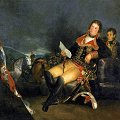 Get
Get  a high-quality picture of
Manuel Godoy, Duke Of Alcudia, 'Prince Of The Peace' for your computer or notebook. ‣
This portrait was painted between July and October 1801 to commemorate the victory in Portugal, the War of the Oranges, so-called because Godoy, Chief Minister, is said to have sent a gift of oranges to the Queen in celebration. The Portuguese banners prominent in the foreground were awarded to Godoy in July and in October he was made Generalissimo of land and sea, which entitled him to wear a blue sash in place of the red sash of Captain General, which he wears here.
a high-quality picture of
Manuel Godoy, Duke Of Alcudia, 'Prince Of The Peace' for your computer or notebook. ‣
This portrait was painted between July and October 1801 to commemorate the victory in Portugal, the War of the Oranges, so-called because Godoy, Chief Minister, is said to have sent a gift of oranges to the Queen in celebration. The Portuguese banners prominent in the foreground were awarded to Godoy in July and in October he was made Generalissimo of land and sea, which entitled him to wear a blue sash in place of the red sash of Captain General, which he wears here.
Goya has portrayed Godoy in an elaborate and unusual composition, in a reclining posture reminiscent of some of his paintings of women on couches, seemingly inappropriate for the hero of a military victory. Goya's portrait hints at disrespect for the pomposity of his sitter, though Godoy was an important patron, a collector on a grand scale, for whom Goya painted many works including the famous portrait of his wife, the Countess of Chinchon. Godoy was also owner of the two Majas and may even have commissioned them.
Goya's friendship with liberal ministers, such as Jovellanos and Saavedra, did not affect the relationship between the First Court Painter and the Chief Minister, whose rapid rise to power, attributed to his liaison with the Queen, made him notorious. Godoy must have been aware of the fact that he had been and still was the target of Goya's satirical wit in several plates of Los Caprichos, the ass looking up his genealogy in a book illustrated with row after row of asses, for instance, and in the etching entitled Birds of a Feather (Tal para qual). According to contemporary commentaries this is a reference to Godoy and Queen Maria Luisa, in particular to an occasion when she was mocked by a group of washerwomen for her unseemly behaviour. Yet despite all this, Godoy in his Memoirs written years later in France referred to Goya's Caprichos with pride as if he had been responsible for their publication.
The Clothed Maja (La Maja Vestida) (1803)
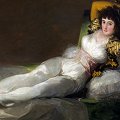 Get
Get  a high-quality picture of
The Clothed Maja (La Maja Vestida) for your computer or notebook. ‣
Though it was no doubt painted earlier, the first record of The Clothed Maja and the first mention of the paintings together is in an inventory of Godoy's collection dated 1 January 1808, where they are called 'gipsies'. In an article on Los Caprichos published in Cadiz in 1811, it is as Goya's Venuses that they are mentioned amongst his most admired works (they are also called Venuses in Goya's biography by his son). The next mention of the Majas is towards the end of 1814, when Goya was denounced to the Inquisition for being the author of two obscene paintings in the sequestrated collection of the Chief Minister Godoy, 'one representing a naked woman on a bed...and the other a woman dressed as a maja on a bed'. On 16 May 1815, the artist was summoned to appear before a Tribunal 'to identify them and to declare if they are his works, for what reason he painted them, by whom they were commissioned and what were his intentions'. Unfortunately Goya's declaration has not yet come to light.
a high-quality picture of
The Clothed Maja (La Maja Vestida) for your computer or notebook. ‣
Though it was no doubt painted earlier, the first record of The Clothed Maja and the first mention of the paintings together is in an inventory of Godoy's collection dated 1 January 1808, where they are called 'gipsies'. In an article on Los Caprichos published in Cadiz in 1811, it is as Goya's Venuses that they are mentioned amongst his most admired works (they are also called Venuses in Goya's biography by his son). The next mention of the Majas is towards the end of 1814, when Goya was denounced to the Inquisition for being the author of two obscene paintings in the sequestrated collection of the Chief Minister Godoy, 'one representing a naked woman on a bed...and the other a woman dressed as a maja on a bed'. On 16 May 1815, the artist was summoned to appear before a Tribunal 'to identify them and to declare if they are his works, for what reason he painted them, by whom they were commissioned and what were his intentions'. Unfortunately Goya's declaration has not yet come to light.
As a pair of paintings of a single figure in an identical pose, the Majas are a highly original invention. The theory that the clothed woman was intended as a cover for the naked one is very credible. It is not surprising that the Majas attracted the attention of the Inquisition in Madrid in 1814. As late as 1865 Manet's Olympia (which bears such a close resemblance to The Naked Maja that it is difficult to believe that the artist had not seen Goya's painting) created a furious scandal when it was exhibited in the Paris Salon.
Dona Isabel De Porcel (1805)
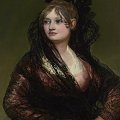 Get
Get  a high-quality picture of
Dona Isabel De Porcel for your computer or notebook. ‣
Goya's fame is as ambiguous as his career. A fashionable court painter and society portraitist, once renowned for his designs of light-hearted decorations, he is now celebrated as a passionate denouncer of injustice and the horrors of war. Supreme recorder of his countrymen's diversions, superstitions and travails, he is also the greatest master of private nightmare, expressed above all in the horrific 'Black Paintings' made for his own house. Perhaps the last great artist working in a style associated with 'anciens regimes' throughout Europe, he has been called 'the first of the moderns'.
a high-quality picture of
Dona Isabel De Porcel for your computer or notebook. ‣
Goya's fame is as ambiguous as his career. A fashionable court painter and society portraitist, once renowned for his designs of light-hearted decorations, he is now celebrated as a passionate denouncer of injustice and the horrors of war. Supreme recorder of his countrymen's diversions, superstitions and travails, he is also the greatest master of private nightmare, expressed above all in the horrific 'Black Paintings' made for his own house. Perhaps the last great artist working in a style associated with 'anciens regimes' throughout Europe, he has been called 'the first of the moderns'.
A painter rivalling Velazquez in the freedom of his brush and his understanding of light and shade, Goya came to be known outside Spain for his engravings, etchings and aquatints, some of the finest ever produced. In a career spanning over sixty years he left some five hundred paintings, most of them still in Spain (where he also executed frescoes), and many more prints and drawings.
Dona Isabel and her husband Don Antonio were close friends of Goya; according to tradition he painted both their portraits during a visit to their home in gratitude for their hospitality. Don Antonio's likeness, formerly in the Jockey Club, Buenos Aires, was subsequently destroyed in a fire.
Dona Isabel wears the dress of a maja - a style originally associated with the demimonde of Madrid, but in the late eighteenth and early nineteenth centuries adopted by ladies of fashion as a token of Spanish patriotism, and also, no doubt, because its black lace mantilla and high waist were madly flattering, as we can see here. The dress justifies the pose, which we know from Flamenco dance: left arm akimbo, torso and head sharply turned in different directions. Perfectly adapted to the half-length format, the protruding right arm and hand providing a stable base for the torso, this pose without the maja connotation would have been unacceptably vulgar in the portrait of a lady. We experience it as wonderfully emancipated.
Goya emphasizes Dona Isabel best features, her eyes and her fresh colouring, without hiding the fleshy nose and slightly underslung jaw; the incipient double chin adds to her youthful charm. Freely painted, the mantilla serves as a dark aureole to her bright face, and tones down the shimmering pink and white bodice in order not to distract from the flesh tones.
Portrait Of Antonia Zarate (1805)
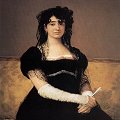 Get
Get  a high-quality picture of
Portrait Of Antonia Zarate for your computer or notebook. ‣
The sitter was a leading actress, mother of the playwright Gil y Zarate and one of several members of the theatrical world portrayed by Goya. She was born in 1775 and was 30 years old at the time when this portrait was probably painted. She died in 1811. Another bust portrait has been dated earlier by some critics and later by others. But the pose and details of her face and coiffure are so similar only the dress and fancy headdress are different that the two portraits cannot be very different in date.
a high-quality picture of
Portrait Of Antonia Zarate for your computer or notebook. ‣
The sitter was a leading actress, mother of the playwright Gil y Zarate and one of several members of the theatrical world portrayed by Goya. She was born in 1775 and was 30 years old at the time when this portrait was probably painted. She died in 1811. Another bust portrait has been dated earlier by some critics and later by others. But the pose and details of her face and coiffure are so similar only the dress and fancy headdress are different that the two portraits cannot be very different in date.
The liveliness of the close-up view of the bust portrait suggests that this may be Goya's first likeness of his beautiful sitter, later transformed into a grand composition. The problem of dating two versions of the same subject is not uncommon in Goya's oeuvre. The yellow settee appears in other portraits by Goya (for example the portrait of Perez Estala in the Kunsthalle, Hamburg) and was probably a studio property. Nowhere, however, does it provide a more effective setting than here, as a background to the lovely dark-haired actress.
Portrait Of A Lady With A Fan (1807)
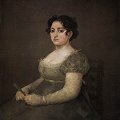 Get
Get  a high-quality picture of
Portrait Of A Lady With A Fan for your computer or notebook. ‣
It has been suggested that this handsome, plump young woman is Goya's daughter-in-law, Gumersinda Goicoechea, and that the portrait was painted shortly before or shortly after the birth of his grandson Mariano. Though it is difficult to judge the resemblance to Goya's other portraits of Gumersinda - a profile drawing, a miniature in near profile and a full-length portrait of a much slimmer and more elegant figure, with a different coiffure - there is a similarity in the features that makes the identification credible. The portrait was in the collection of Goya's son but when it left his collection the name of the sitter was forgotten.
a high-quality picture of
Portrait Of A Lady With A Fan for your computer or notebook. ‣
It has been suggested that this handsome, plump young woman is Goya's daughter-in-law, Gumersinda Goicoechea, and that the portrait was painted shortly before or shortly after the birth of his grandson Mariano. Though it is difficult to judge the resemblance to Goya's other portraits of Gumersinda - a profile drawing, a miniature in near profile and a full-length portrait of a much slimmer and more elegant figure, with a different coiffure - there is a similarity in the features that makes the identification credible. The portrait was in the collection of Goya's son but when it left his collection the name of the sitter was forgotten.
The Colossus (1808)
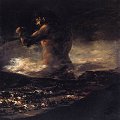 Get
Get  a high-quality picture of
The Colossus for your computer or notebook. ‣
The painting sometimes is also called Panic.
a high-quality picture of
The Colossus for your computer or notebook. ‣
The painting sometimes is also called Panic.
The giant is shown standing, his fists clenched for battle. The landscape is full of streams of people fleeing with their cattle.The painting makes it clear that mankind is dominated by fate, a force between heaven and earth. The demonic element, that has power over the earth, is depicted like a dream. Goya is basically using a Baroque device, allegory. He just makes the painting difficult to interpret, for we do not know whether the figure is intended to be a personification of revolution itself, of mankind exploding in rage, or its opposite, danger taking on visionary form.
Allegory Of The City Of Madrid (1810)
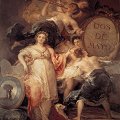 Get
Get  a high-quality picture of
Allegory Of The City Of Madrid for your computer or notebook. ‣
At the end of 1809, during the French occupation of Madrid, Goya was chosen as 'el pintor madrileno por excelencia' to paint a portrait of Joseph Bonaparte for the City Council. In the absence of the French King, Goya composed this picture, described at the time as 'certainly worthy of the purpose for which it was intended', introducing the portrait of Joseph (after an engraving) in the medallion, to which the figure personifying Madrid points. With the changing fortunes of the war this portrait was replaced (by other hands) by the word 'Constitucion', by another portrait of Joseph, again by 'Constitucion' and at the end of the war by a portrait of Ferdinand VII. Eventually in 1843 it received the present inscription 'DOS DE MAYO' ('The second of May') in reference to the popular rising against the French in Madrid in 1808. The surprisingly conventional allegorical composition is perhaps dictated by the purpose for which it was originally painted. It contrasts strikingly with the realism and fervour of the scenes from the rising which Goya painted four years later.
a high-quality picture of
Allegory Of The City Of Madrid for your computer or notebook. ‣
At the end of 1809, during the French occupation of Madrid, Goya was chosen as 'el pintor madrileno por excelencia' to paint a portrait of Joseph Bonaparte for the City Council. In the absence of the French King, Goya composed this picture, described at the time as 'certainly worthy of the purpose for which it was intended', introducing the portrait of Joseph (after an engraving) in the medallion, to which the figure personifying Madrid points. With the changing fortunes of the war this portrait was replaced (by other hands) by the word 'Constitucion', by another portrait of Joseph, again by 'Constitucion' and at the end of the war by a portrait of Ferdinand VII. Eventually in 1843 it received the present inscription 'DOS DE MAYO' ('The second of May') in reference to the popular rising against the French in Madrid in 1808. The surprisingly conventional allegorical composition is perhaps dictated by the purpose for which it was originally painted. It contrasts strikingly with the realism and fervour of the scenes from the rising which Goya painted four years later.
Portrait Of Victor Guye (1810)
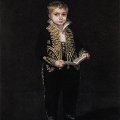 Get
Get  a high-quality picture of
Portrait Of Victor Guye for your computer or notebook. ‣
The sitter, only six or seven years old, wears the uniform of page to Joseph Bonaparte. He was the nephew of General Nicolas Guye, who was also portrayed by Goya in 1810 (Virginia Museum of Fine Arts, Richmond). According to an inscription on the back of the canvas, the two portraits were painted as pendants. During the French occupation of Madrid - at the time when he was working on the drawings for the Desastres de la Guerra - Goya painted several portraits of Frenchmen and pro-French Spaniards. Little or nothing of his avowed hostility to the French invaders is revealed in these works, least of all in this sympathetic portrayal of a French child.
a high-quality picture of
Portrait Of Victor Guye for your computer or notebook. ‣
The sitter, only six or seven years old, wears the uniform of page to Joseph Bonaparte. He was the nephew of General Nicolas Guye, who was also portrayed by Goya in 1810 (Virginia Museum of Fine Arts, Richmond). According to an inscription on the back of the canvas, the two portraits were painted as pendants. During the French occupation of Madrid - at the time when he was working on the drawings for the Desastres de la Guerra - Goya painted several portraits of Frenchmen and pro-French Spaniards. Little or nothing of his avowed hostility to the French invaders is revealed in these works, least of all in this sympathetic portrayal of a French child.
Les Vieilles Or Time And The Old Women (1812)
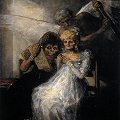 Get
Get  a high-quality picture of
Les Vieilles Or Time And The Old Women for your computer or notebook. ‣
The mark 'X23' at the bottom of the canvas identifies this as a painting listed in 1812 in the inventory of paintings in Goya's house allocated to his son Javier. It probably hung next to one or other of two versions of Majas on a Balcony that bears the number X24. The painting of Les Jeunes or the Young Ones (A Woman Reading a Letter), long thought to have been a pendant and later sharing the same history, was possibly intended as such, although painted a year or two later.
a high-quality picture of
Les Vieilles Or Time And The Old Women for your computer or notebook. ‣
The mark 'X23' at the bottom of the canvas identifies this as a painting listed in 1812 in the inventory of paintings in Goya's house allocated to his son Javier. It probably hung next to one or other of two versions of Majas on a Balcony that bears the number X24. The painting of Les Jeunes or the Young Ones (A Woman Reading a Letter), long thought to have been a pendant and later sharing the same history, was possibly intended as such, although painted a year or two later.
Exceptional in its way as a life-size Capricho, the scale makes the satirical purport the more forceful. But though the general meaning is clear - the ridiculing of the pretentiousness and vanity of the rich and old and ugly - the exact message 'Que tal?' ('How goes it?') on the back of the mirror is not spelt out. A similar theme, without the figure of Time, which is the subject of Plate 55 of Los Caprichos, has lent itself to interpretation as a reference to the Dowager Duchess of Osuna, and also to Queen Maria Luisa, renowned for her vanity and her ugliness. In support of such an allusion, though the Queen had long since left Spain when this painting was made, one of these old women wears a diamond arrow similar to that worn by Maria Luisa in the group portrait of Charles IV and his Family.
Goya's son was no doubt referring to this and other paintings that Goya owned in 1812 when he wrote in one of his biographies of his father that Goya was specially interested in the paintings in his house 'because they were made with all the liberty that ownership affords; a liberty which led him in some cases to use the palette knife instead of the brush...and he particularly enjoyed seeing them every day'.
Portrait Of The Duke Of Wellington (1812)
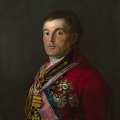 Get
Get  a high-quality picture of
Portrait Of The Duke Of Wellington for your computer or notebook. ‣
Wellington is the only Englishman, and one of very few foreigners, to have had their portraits painted by Goya. As victor of the Battle of Salamanca, the Earl of Wellington and Lieutenant-General, as he then was, had liberated Madrid from the French, entering the city in August 1812, when he sat for Goya. He is shown with the decorations of three Orders, the Bath (topmost star), the Tower and Sword of Portugal (lower left), and San Fernando of Spain (lower right). The insignia of the Golden Fleece was probably added to the costume later in the month, and the uniform altered to an approximation of Wellington's dress uniform as general. Originally he had been painted wearing the oval Peninsular Medallion; Goya retouched the portrait two years later, when Wellington returned as ambassador to the restored King Ferdinand VII and the medallion had been replaced by the Military Gold Cross.
a high-quality picture of
Portrait Of The Duke Of Wellington for your computer or notebook. ‣
Wellington is the only Englishman, and one of very few foreigners, to have had their portraits painted by Goya. As victor of the Battle of Salamanca, the Earl of Wellington and Lieutenant-General, as he then was, had liberated Madrid from the French, entering the city in August 1812, when he sat for Goya. He is shown with the decorations of three Orders, the Bath (topmost star), the Tower and Sword of Portugal (lower left), and San Fernando of Spain (lower right). The insignia of the Golden Fleece was probably added to the costume later in the month, and the uniform altered to an approximation of Wellington's dress uniform as general. Originally he had been painted wearing the oval Peninsular Medallion; Goya retouched the portrait two years later, when Wellington returned as ambassador to the restored King Ferdinand VII and the medallion had been replaced by the Military Gold Cross.
Arthur Wellesley, first Duke of Wellington, 43 when the portrait was made and greying at the temples, looks out from above his medals with an alert and good-humoured air. Goya often gave his sitters an animated expression by showing them with their mouths slightly open; even the Queen of Spain, Maria Luisa, shows her teeth in a famous group portrait of 1800 - an unthinkable breach of etiquette in any earlier age. Here, the duke's short upper lip is drawn up over two large English front teeth, a 'speaking likeness'. He is unlikely to have been speaking to Goya, who was totally deaf as a result of an illness in 1792 and could communicate only in sign language and by writing.
'He painted only in one session, sometimes of ten hours, but never in the (late) afternoon. The last touches for the better effect of a picture he gave at night, by artificial light', wrote Goya's son, Francisco Javier, in his biography of the artist. The liveliness of this portrait suggests it is painted from life (although it is doubtful that 'Senor Willington', as Goya called him, sat for the full ten hours). The glitter of the decorations, so much bolder than the highlights on the flesh or the catchlights in the eyes, equally suggests that they may have been touched up at night. We know that both uniform and decorations were altered by Goya after the first sitting.
There are two known portraits in oils of Wellington by Goya, one large equestrian portrait (Apsley House, London) and this bust as well as two drawings. A third painting of Wellington with hat and cloak (National Gallery of Art, Washington) is no longer considered to be by Goya. All are related, but the order of their execution and their precise interrelations are difficult to determine. It has been suggested that the drawings may have been made in preparation for an etching that was never executed. The British Museum drawing, in which the head most closely resembles the head in the paintings, may, however, have served as a study for these. An inscription on this drawing says that it was a study for the equestrian portrait and an accompanying note (said to be in the hand either of Goya's grandson or of his friend Carderera), that it was made at Alba de Tormes after the Battle of Arapiles (i.e. Salamanca). The battle was fought on 22 July 1812 and Wellington was at Alba de Tormes on the following day, but it is unlikely that he was able to sit to Goya before he entered Madrid on 12 August. The equestrian portrait, the only one for which documents exist, must have been painted between 12 August and 2 September, when it was to be exhibited in the Academy of San Fernando.
The National Gallery painting was probably painted before he left Madrid on 1 September 1812, at the same time as the equestrian composition, when Wellington was still Earl of Wellington and Lieutenant-General. Of the two paintings, the head in the National Gallery version is the most animated and the most likely to have been taken from life. It is also the only one that represents Wellington in full military costume and the most ceremonial in appearance. Some of the decorations that he wears were received after he left Madrid in 1812 and the alterations that are visible in the painting may have been made in May 1814, when Wellington returned there as Ambassador to Ferdinand VII.
Still-Life, A Butcher's Counter (1812)
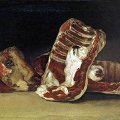 Get
Get  a high-quality picture of
Still-Life, A Butcher's Counter for your computer or notebook. ‣
A dozen bodegones (still lifes) and a painting of birds are recorded in the inventory of Goya's possessions made in 1812 after the death of his wife, and according to his French biographer, Matheron, he painted several still lifes in the market at Bordeaux during his last years there. The present example bears traces of the inventory mark that identifies the earlier group, and is remarkable for the period because of the casual arrangement of the sheep's head with its expressive eye, and sides of mutton. The signature is painted in red as if to simulate blood. For stylistic reasons this and other still lifes of the group - pictures of meat, fish, fowl and game - cannot be much earlier than the date they are recorded in Goya's house. This means that they must have been painted about the time of the 'ano del hambre', the year of the terrible famine in Madrid in 1811-12, when thousands died of hunger, thus raising the question of whether any allusion to the famine was intended by Goya. Were they perhaps meant as a sardonic commentary on the situation in one of the many illustrations of the effects of famine in his Desastres de la Guerra? A well-dressed woman stands before a group of starving victims, some dying, some dead, with the caption: 'The worst is to beg'.
a high-quality picture of
Still-Life, A Butcher's Counter for your computer or notebook. ‣
A dozen bodegones (still lifes) and a painting of birds are recorded in the inventory of Goya's possessions made in 1812 after the death of his wife, and according to his French biographer, Matheron, he painted several still lifes in the market at Bordeaux during his last years there. The present example bears traces of the inventory mark that identifies the earlier group, and is remarkable for the period because of the casual arrangement of the sheep's head with its expressive eye, and sides of mutton. The signature is painted in red as if to simulate blood. For stylistic reasons this and other still lifes of the group - pictures of meat, fish, fowl and game - cannot be much earlier than the date they are recorded in Goya's house. This means that they must have been painted about the time of the 'ano del hambre', the year of the terrible famine in Madrid in 1811-12, when thousands died of hunger, thus raising the question of whether any allusion to the famine was intended by Goya. Were they perhaps meant as a sardonic commentary on the situation in one of the many illustrations of the effects of famine in his Desastres de la Guerra? A well-dressed woman stands before a group of starving victims, some dying, some dead, with the caption: 'The worst is to beg'.
Francisco de Goya Art

|
|
More
Articles
 Art Encyclopedia A world history of art in articles.
Art Encyclopedia A world history of art in articles.
Romanticism
Francisco de Goya
Life and biography.
Art of Goya.
Early paintings by Goya.
Intermediate paintings by Goya.
Late paintings by Goya.
Art
 Art Wallpapers Art image collections for your desktop.
Art Wallpapers Art image collections for your desktop.
Goya Art, $25
(115 pictures)
Aivazovsky Art, $29
(145 pictures)
Bouguereau Art, $25
(175 pictures)
